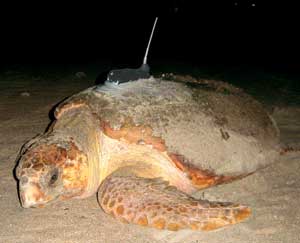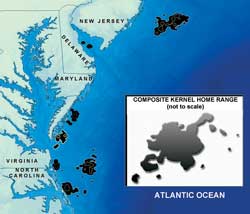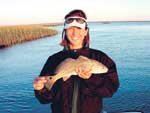ArcUser Online
Data from satellite transmitters attached to female sea turtles was analyzed using GIS to better understand the turtles' movements and protect them. Currently, loggerhead sea turtles (Caretta caretta) are listed as threatened under the United States Endangered Species Act of 1973. Since the mid-20th century, researchers and volunteers have spent countless hours protecting female sea turtles and their nests. Until recently, where sea turtles went after nesting was a mystery. However, with the introduction of satellite telemetry and desktop GIS, females can be tracked after leaving the nesting beach. Information derived from flipper tagging and satellite telemetry studies indicates that most adult female loggerheads from Georgia, North Carolina, and South Carolina migrate to the Mid-Atlantic Bight. [A bight is a mariner's term for a bend or curve in an open coastline; the Mid-Atlantic Bight extends from Cape Hatteras, North Carolina, to Cape May, New Jersey.] The Mid-Atlantic Bight is an important spring, summer, and fall foraging area. Resident foraging areas (RFAs) are vital to loggerheads who exhaust their fat stores laying approximately 500 eggs per turtle each season. From 1998 to 2003, satellite transmitters were attached to 20 adult female loggerheads at nesting beaches at Wassaw Island, Georgia, and Cape Island, South Carolina. Satellite locations, received via e-mail, were acquired from four polar orbiting satellites using Service Argos, Inc. (www.argosinc.com). Coordinates were in latitude and longitude, in thousandths of decimal degrees, and based on the World Geodetic System (WGS84) datum. A composite sea turtle home range analysis had never been conducted. Most projects have studied individual turtles. This approach rarely provides enough location data to confidently make statements about the home range. Initially, loggerhead migrations away from the nesting beach were tracked using ArcView. With GIS, stringent analysis could be applied to estimate the home range size while turtles were in RFAs. Filtered data was imported into ArcView 3.2a for home range analyses using the Animal Movement Extension for ArcView 3.x. [Tools mentioned are listed with source and attribution in the accompanying chart.] Each RFA was tested for site fidelity in the Azimuthal Equidistant (equatorial) projection by performing 1,000 random movements from the first point within an RFA. Before running the site fidelity test, graphic boundaries were constructed to confine random movements to the ocean. If a turtle exhibited site fidelity, its data was used for a composite home range analysis.
The composite RFA was constructed from 13 site-specific RFAs. The unweighted geographic mean was determined for each RFA using Jenness Enterprises' Weighted Mean of Points extension for ArcView 3.x. The distance and azimuth for each point were calculated from the geographic mean. Each point was repositioned relative to an arbitrary point (x, y) using Zhou's Bearing and Distance extension in the Azimuthal Equidistant projection. New decimal degree coordinates were added to the data in the geographic projection using the Coordinates Tool Box extension because each point had moved to a new geographic location relative to this arbitrary point. The fixed kernel density (FKD) model was used to estimate the size of the composite RFA in the Albers Equal Area projection. This home range size can be incorporated into conservation management strategies for loggerhead sea turtles. ArcView 3.2a was used instead of ArcGIS 8.3 because, currently, there are no home range analysis extensions or scripts available for this platform. However, ArcGIS 8.3 was used to determine mean water depths using the Gridspot extension. One objective of this study was to determine if RFAs coincide with areas where commercial fishery activities, such as shrimp trawling, gillnetting, and long-lining, are carried out. These activities can cause substantial sea turtle mortality. If these areas are coincident, Special Management Zones (SMZs) may need to be designated to protect turtles. Using the composite RFA, minimum SMZ size designations were estimated with tools provided in the GIS environment. In the future, collaboration with researchers on additional loggerhead satellite telemetry projects will further streamline this home range analysis and make the argument for SMZs stronger. Home range analyses would greatly benefit from several software applications. A program is needed that runs an FKD bootstrap and calculates the asymptote from it. [An asymptote is a line whose distance to a given curve tends to zero and may or may not intersect its associated curve.] Also, the Animal Movement Extension for ArcView 3.x needs to be further developed so that the entire extension runs in the ArcGIS environment and the site fidelity test works with linear home ranges. For more information, contact DuBose B. Griffin About the Author
DuBose B. Griffin is an endangered species biologist for the South Carolina Department of Natural Resources. She holds a bachelor's degree in biology with a chemistry minor from Appalachian State University, North Carolina, and a master's degree in environmental policy from the graduate school at the College of Charleston, South Carolina. She has worked on a variety of GIS mapping and planning projects on coastal species of concern.
|


